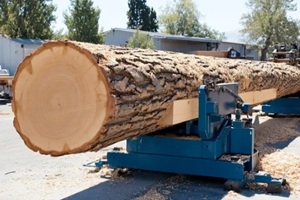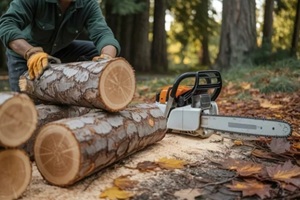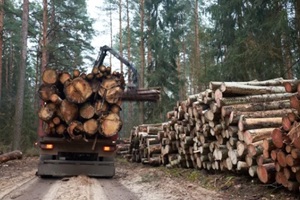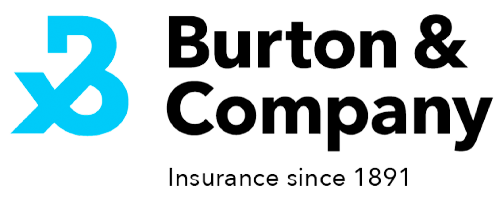
Logging equipment is a significant investment, and it’s not just the cost of the machinery that’s at stake. Downtime, loss of productivity, and insurance claims can all take a toll on the operations of a logging company. Theft and damage are common risks to equipment in the woods, at a job site, or even during transport.
While insurance can help manage the financial burden, taking other preventive steps can help logging companies avoid these incidents altogether and prevent heightened premiums due to frequent claims.
Here’s what logging companies should know about protecting their gear and reducing losses.
Why Logging Equipment Is a Target
Chainsaws, skidders, loaders, harvesters, and other heavy machinery are often left on job sites for long periods, especially in remote locations, creating an opportunity for thieves or vandals. According to the National Equipment Register (NER), theft of construction and agricultural equipment costs businesses between $300 million and $1 billion annually. Logging machines typically fall into this category.
In addition to theft, damage from vandalism or unauthorized use can add to repair and replacement costs. Some equipment may also be vulnerable to weather-related issues if not properly secured. Environmental exposure can deteriorate machinery faster than expected, leading to mechanical failure or increased maintenance expenses.
Tips for Preventing Theft and Damage
Preventing losses starts with a proactive strategy. Here are several steps logging companies can take to reduce their risk.
1. Mark and Track Equipment
- Use GPS tracking devices on all major equipment for a quick recovery in the event of theft.
- Etch or paint serial numbers or company identifiers onto machines and components.
- Register equipment with the National Equipment Register.
These steps deter theft and help law enforcement recover stolen items faster.
2. Improve Job Site Security
- Store equipment in well-lit, secured areas when not in use.
- Use locking fuel caps and disable equipment batteries overnight.
- Install security cameras or trail cams on remote job sites.
- Set up fencing or barriers where possible to limit unauthorized access.
Job sites that look difficult to access or well-monitored are less likely to be targeted.
3. Screen and Train Employees

Background checks and thorough training help reduce the risk of internal theft and accidental damage. Recent insurance studies show employee theft costs businesses an estimated $50 billion annually.
Encourage reporting of suspicious behavior and enforce clear policies around equipment use and site access. Building a trusted team around a culture of integrity is one of the most effective ways to protect valuable assets.
4. Secure Equipment During Transport
- Use lockable trailers or enclosures during hauling.
- Choose well-lit, secure areas for overnight stops.
- Confirm proper tie-downs to prevent damage in transit.
Losses can happen just as easily on the road as on a job site. Make sure each transportation plan includes a security checklist.
Insurance Coverage Matters
Even with the best protections in place, incidents can still occur, giving insurance a valuable role. Logging companies should work with a provider that understands the industry’s needs and offers appropriate coverage.
Types of Insurance to Consider
- Equipment Insurance: Covers physical damage or theft of machinery and tools.
- Commercial Auto Insurance: Protects equipment transported on vehicles or trailers.
- General Liability Insurance: Helps cover third-party property damage or injuries.
- Property Insurance: Covers losses at fixed locations such as storage yards.
Certain providers specialize in logging insurance and can advise on appropriate limits, deductibles, and additional protections. The USDA also provides guidance on property protection and emergency response planning for rural businesses.
Reporting and Recovery Tips
If equipment is stolen or damaged, prompt action can reduce losses and increase the chances of recovering your property:
- File a police report immediately and gather all relevant documentation, including the case number.
- Notify your insurance provider as soon as possible.
- Provide serial numbers, photos, and GPS data if available.
- Monitor online marketplaces for listings of stolen items.
The National Crime Information Center (NCIC) allows law enforcement to track stolen machinery through shared databases.
Contact Burton & Company for Your Equipment Insurance Needs

Every logging operation presents different risks, and there is no one-size-fits-all solution to protecting expensive equipment. Working with a knowledgeable insurance provider can make a substantial difference. Burton & Company has been serving businesses in Virginia for decades and understands the specialized needs of the logging industry.
We can help assess your current coverage, identify gaps, and recommend policies that fit your operation. If you want to reduce losses, protect your equipment, and keep your business running smoothly, Burton & Company is ready to help.
Contact Burton & Company online or by phone at (888) 652-1325 to discuss your logging insurance needs with an experienced advisor.

